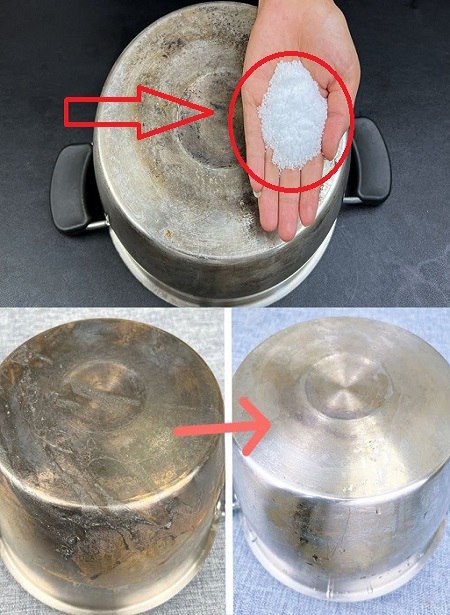ADVERTISEMENT
Why it Works:
Baking soda works as a natural abrasive, helping to lift burnt food and stains without damaging your pan. The paste also helps to soften the residue, making it easier to scrub away.
Method 3: Lemon Juice and Baking Soda for Stainless Steel Pans
Lemon juice is another natural acid that works wonders in cleaning burnt-on food, especially for stainless steel pans.
Steps:
- Add Lemon Juice: Squeeze the juice of half a lemon directly onto the burnt area of the pan. For extra cleaning power, you can sprinkle a little baking soda over the lemon juice.
- Let it Sit: Allow the lemon juice and baking soda to fizz and sit for 5-10 minutes. The acid in the lemon juice breaks down the grease, while the baking soda provides an abrasive element.
- Scrub and Scrape: Use a soft sponge or a wooden spoon to scrub away the residue. For tough spots, you can use the coarse side of the sponge.
- Rinse and Dry: Rinse the pan thoroughly with warm water and dry it with a cloth.
Why it Works:
Lemon juice is acidic and naturally cuts through grease and burnt food. Combined with the abrasive power of baking soda, this method works efficiently on stainless steel cookware to remove burnt-on stains and food.
Method 4: Boiling Water with Baking Soda (for Cast Iron Pans)
For cast iron pans, it’s important to avoid using soap or harsh scrubbing pads, as these can strip the seasoning of the pan. Instead, a boiling water and baking soda method works perfectly for lifting stubborn burnt food without compromising the seasoning.
Steps:
- Fill with Water: Add enough water to cover the bottom of the cast iron pan (about 2-3 cups, depending on the size of the pan).
- Add Baking Soda: Stir in 1-2 tablespoons of baking soda into the water.
- Bring to a Boil: Bring the mixture to a boil over medium heat. As the water boils, it will loosen any burnt food stuck to the surface.
- Scrape and Clean: Use a wooden spatula to gently scrape off the burnt food as the water boils. You may need to repeat the boiling process if the food is especially stubborn.
- Rinse and Dry: Once the pan is clean, pour out the water and dry the pan thoroughly to avoid rusting.
Why it Works:
Baking soda is mildly abrasive and helps to lift the burnt food particles without damaging the seasoning of the cast iron. Boiling the water helps loosen the food, making it easier to remove without scrubbing.
Method 5: Salt and Water for Non-Stick Pans
Non-stick pans require extra care to avoid damaging the coating, so this method uses salt and water, which is gentle yet effective at removing burnt residue.
Steps:
- Sprinkle Salt: Sprinkle a generous amount of coarse salt (such as kosher salt) into the bottom of the pan.
- Add Water: Add just enough water to cover the burnt areas of the pan.
- Heat the Pan: Heat the pan over medium heat for a few minutes. The heat, combined with the abrasiveness of the salt, will help lift the burnt food.
- Scrub Gently: Use a soft cloth or sponge to gently scrub away the burnt food. Avoid using anything abrasive that could damage the non-stick coating.
- Rinse and Dry: Rinse the pan thoroughly with warm water and dry it with a soft towel.
Why it Works:
Salt is an abrasive that helps to lift food residue, while the water helps to loosen the burnt particles without damaging the non-stick coating.
Final Tips:
- Always Test First: Always test these methods on a small area of the pan, especially if you’re cleaning a delicate surface like a non-stick pan.
- Preventative Care: To prevent burnt food from sticking in the future, avoid using high heat for long periods, and be sure to regularly season your cast iron or non-stick pans.
- Regular Cleaning: Clean your pans regularly after each use to prevent residue from building up, making it easier to maintain their condition.
Conclusion:
Cleaning burnt pans doesn’t have to be a daunting task. With these simple, natural methods using baking soda, vinegar, lemon juice, and salt, you can easily restore your cookware to its former shine in seconds. These ingredients are not only effective, but they are safe and gentle on your pans, ensuring that your favorite cookware lasts longer and stays in good condition. So next time you’re faced with a burnt pan, skip the harsh chemicals and try these natural cleaning methods for quick and easy results!
ADVERTISEMENT
